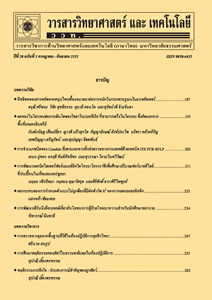การแยกสลายของผสมฟางข้าวและถ่านหินด้วยความร้อนโดยใช้คลื่นไมโครเวฟ
Main Article Content
Abstract
บทคัดย่อ
งานวิจัยนี้ทำการศึกษาการแยกสลายของผสมระหว่างฟางข้าวกับถ่านหินด้วยความร้อนโดยใช้คลื่น microwave โดยศึกษาผลของตัวแปรต่าง ๆ อันได้แก่ สัดส่วนของฟางข้าวต่อถ่านหิน (100:0, 90:10, และ 50:50) ปริมาณความชื้นเริ่มต้นในตัวอย่าง [ร้อยละ (โดยน้ำหนัก) 27 และ 37] เวลาของการให้ความร้อน (10-25 นาที) และกำลังของคลื่นไมโครเวฟ (350-700 วัตต์) ที่มีผลต่อผลิตภัณฑ์ที่ได้จากการแยกสลายด้วยความร้อน อันได้แก่ solid yield ผลการวิเคราะห์แบบประมาณ (proximate analysis) และค่าความร้อน (heating value) ของผลิตภัณฑ์ของแข็ง (solid product หรือ char) ที่ได้ จากผลการทดลองพบว่าสัดส่วนของฟางข้าวต่อถ่านหินและกำลังของคลื่นไมโครเวฟ มีผลเพียงเล็กน้อยต่อค่า solid yield โดย solid yield มีค่าอยู่ในช่วงประมาณร้อยละ 30-60 ทั้งนี้ เวลาของการให้ความร้อนที่นานขึ้น ส่งผลให้ค่า solid yield มีแนวโน้มลดลง แต่ solid yield มีค่าสูงขึ้น เมื่อตัวอย่างมีความชื้นเริ่มต้นเพิ่มขึ้น สัดส่วนของฟางข้าวต่อถ่านหิน เวลาของการให้ความร้อน และกำลังของคลื่นไมโครเวฟ มีผลน้อยมากต่อผลการวิเคราะห์แบบประมาณของตัวอย่างที่ได้จากการแยกสลายด้วยความร้อน ทั้งนี้พบว่าตัวอย่างที่ได้จากการแยกสลายด้วยความร้อนมีสัดส่วนของสารระเหยได้ (volatile matter) ลดลง ขณะที่มีสัดส่วนของคาร์บอนคงตัว (fixed carbon) มากขึ้น เมื่อเทียบกับตัวอย่างก่อนการแยกสลายด้วยความร้อน อย่างไรก็ตาม พบว่าเมื่อความชื้นเริ่มต้นในตัวอย่างเพิ่มขึ้นจากร้อยละ 27 เป็นร้อยละ 37 มีผลทำให้ปริมาณสารระเหยได้ (volatile matter) ในผลิตภัณฑ์ที่ได้มีค่าเพิ่มขึ้น แต่ทำให้ปริมาณคาร์บอนคงตัว (fixed carbon) ลดลง เมื่อวิเคราะห์ค่าความร้อน (heating value) ของผลิตภัณฑ์ที่ได้ พบว่าผลิตภัณฑ์ของแข็งที่ได้จากการแยกสลายด้วยความร้อนมีค่า ประมาณ 14-15 MJ/kg ทั้งนี้พบว่าเมื่อความชื้นเริ่มต้นในตัวอย่างเพิ่มขึ้น ค่าความร้อนของผลิตภัณฑ์ของแข็งที่ได้มีแนวโน้มลดลง และพบว่าเมื่อทำการแยกสลายด้วยความร้อนด้วยเวลาที่นานขึ้น ค่าความร้อนของผลิตภัณฑ์ของแข็งที่ได้มีค่าเพิ่มขึ้น
คำสำคัญ : ชีวมวล; ถ่านหิน; การแยกสลายด้วยความร้อน; ไมโครเวฟ; ผลการวิเคราะห์แบบประมาณ; ค่าความร้อน
Abstract
This research aimed to study the thermal decomposition of straw and coal blends using microwave radiation as a heating medium. The effects of straw/coal ratio (100:0, 90:10, and 50:50), initial moisture content of the sample (27 and 37 wt. %), heating period (10-25 min), and microwave power (350-700 Watts) on solid yield and characteristics of the resulting solid products (chars), including proximate analysis and heating value, were investigated. It was found, from the experiments, that the straw/coal ratio and microwave power had insignificant effects on solid yield, which was found to be within the range of 30-60 %. An increase in heating period resulted in a decrease in solid yield. However, when sample’s initial moisture content was increased from 27 to 37 wt. %, solid yield was found to increase. Straw/coal ratio, heating time, and microwave power had negligible effects on proximate analysis of the resulting solid products. When compared to the samples before passing through the thermal decomposition process, the portion of volatile matter in the resulting solid chars was found to decrease, whereas the portion of fixed carbon was found to increase. However, an increase in initial moisture content of the sample led to an increase in volatile matter, but a decrease in fixed carbon, of the resulting solid products. The heating values of the resulting solid chars were in the range of 14-15 MJ/kg. It was also found that, when the initial moisture content of the sample was increased, the heating values of solid products decreased, and that the heating values of the resulting solid chars increased with an increase in the heating period.
Keywords: biomass; coal; pyrolysis; microwave; proximate analysis; heating value

